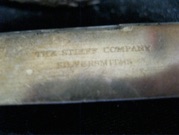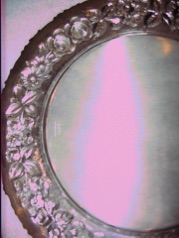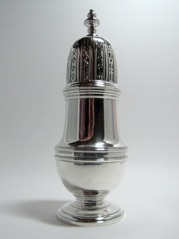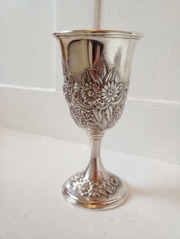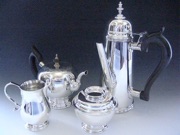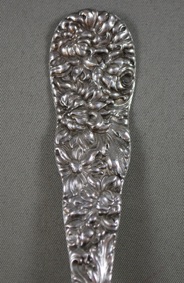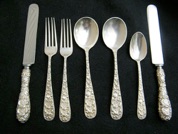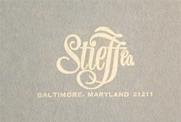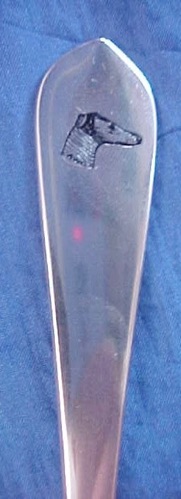
Sterling SIlver



Sterling SIlver



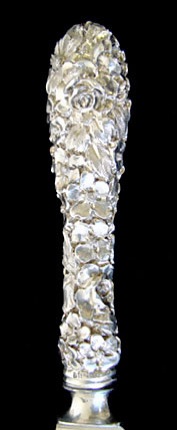
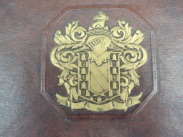
To view the 1952 STIEFF Dealers Book of
Williamsburg Sterling Silver
Click the link below
1952 Williamsburg Restoration Sterling Silver

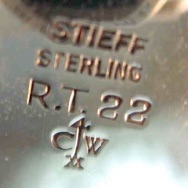
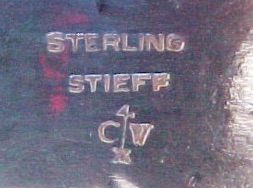
Pre-1949 marks
Pieces made prior to 1949 had the CW mark shown above, below is are examples of 1949 marks. Note that the CW is now encircled with an oval (O is the date mark for 1949)
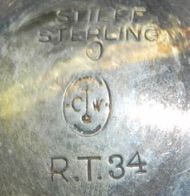
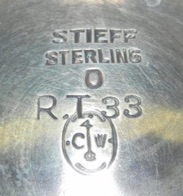
Later marks will incorporate the words Colonial Restoration inside the oval,
as show on the pamphlet below.
This pamphlet of Stieff Williamsburg Restoration Sterling
was printed in July 1952. The Office of Price Stabilization
(OPS) controlled prices on all consumer goods at this time.
(More on the OPS at the bottom of the page)
Pamphlets
July 1952
This pamphlet is from my personal collection of Stieff items.
It measures in inches, 6 & 1/4 tall by 3 & 3/8 wide.
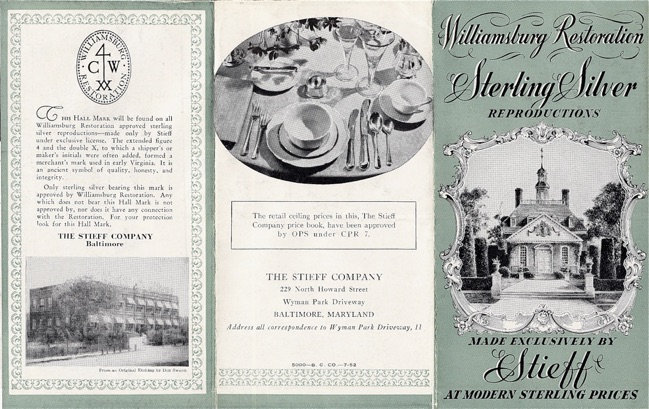
Front and back covers, left panel is the inside flap.

Center panel has a pice of paper glued over the original price list. The prices under the new list were higher than the new ones. The 2 piece carving set RT 14 dropped from 48to 40 dollars. Item RT 2, a luncheon knife was 9.49 and dropped to 7.75 Holloware prices did not change.
RT stands for Raliegh Tavern, one of the Colonial Williamsburg restaurants. The original Raleigh Tavern was also a favorite in colonial times.
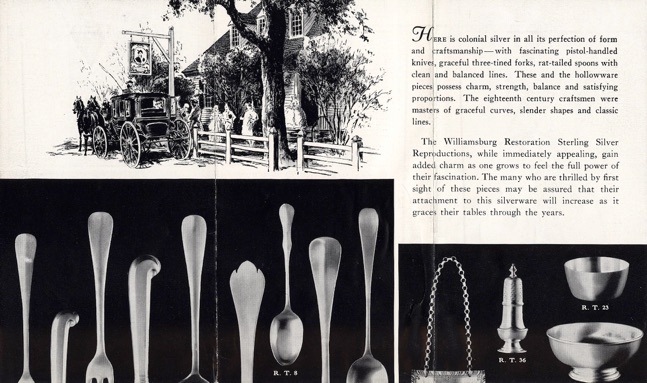

This is the inside panel opened up.
Note the pattern has a slight change in the RT 8 COFFEE SPOON as it has a “Corseted” handle.
Also the RT 6 Tablespoon is notched.
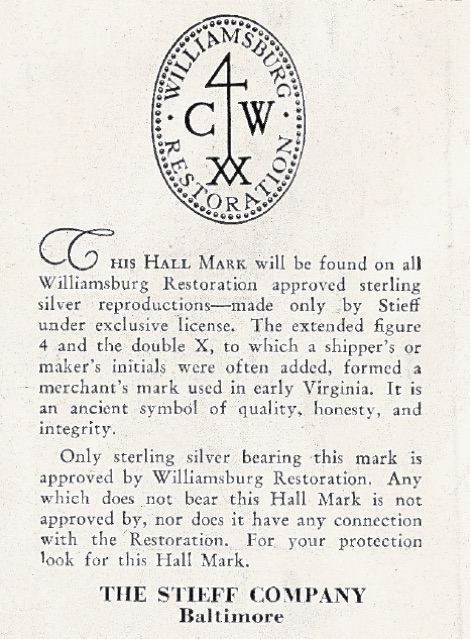
Below, an undated piece showing the item number and name of various
Sterling Silver pieces made by Stieff for Williamsburg.
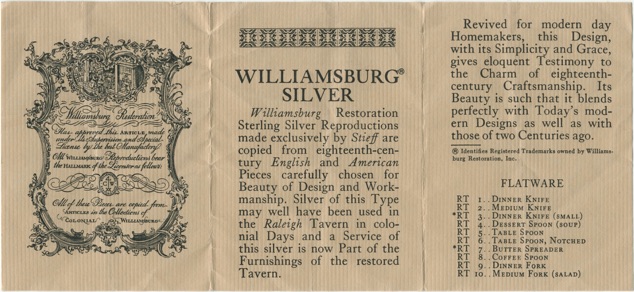
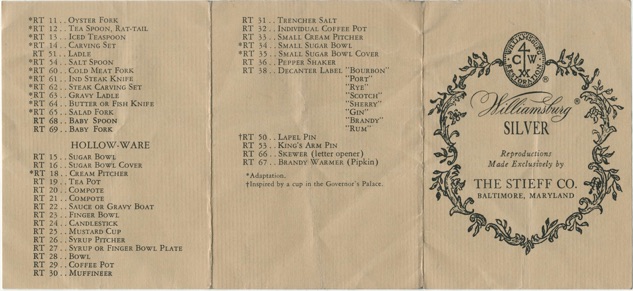
Note that RT 6, called here a notched spoon is actually at Trefid or Trifid spoon.
Trefid spoon or Trifid is a flat-handled spoon having a stem that widens at the top and has two notches that form it into a three-lobed shape suggestive of a clef hind's hoof (hence the French term "pied-de-biche")
The trifid/trefid is the earliest English flatware "pattern" in which the stems of both the spoon and the fork were made to match. These spoons have the bowl with a rat-tail support and were usually engraved with initials or, sometimes, with a foliate design. The trifid pattern was introduced in England when the court returned from exile and had a comparatively short life from about 1660 until the early eighteenth century.
Above info from www.silvercollection.it/dictionarytrifidspoon.html
In 1939, Colonial Williamsburg honored Stieff
by making them the licensed makers of Sterling Silver products for the Colonial Restoration.
In 1940 this formal catalog was produced to showcase those wares. It is on heavy stock paper, with a ragged edge and a corded binding. Very similar to how wedding invitations of the period would have been printed.
From my private collection of Stieff paper goods.
To view this fifteen page catalog, click on the catalog
Another unusual piece was the SUCKET Fork
created by Stieff in sterling for Williamsburg.


A "Sucket Fork" was a utensil used for eating sweetmeats, literally called 'sucket' in Europe. It usually had a two tined fork at one end & a teaspoon size spoon "bowl", on the other end. A sucket fork is mentioned in Edward VI’s estate household silver inventory of 1549. Most of the rare surviving American examples and English sucket forks, date back to the late 1600s.
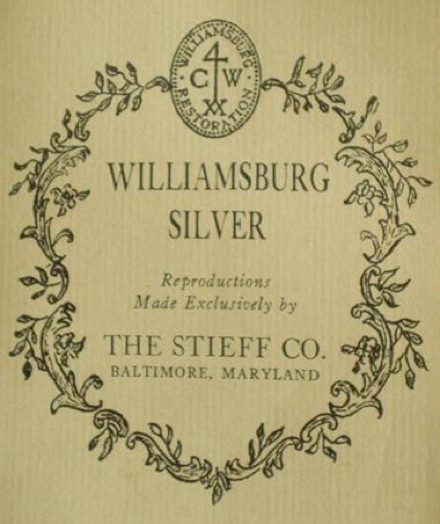
A necklace made of the the Coat of Arms used at Williamsburg

Inspired by a cup in the Governors Palace, these pins
were made by Stieff, post WWII
Below are two examples of the same item. One with the Williamsburg hallmark, and one with out, and yet both are Stieff creations. The RT50 most likely was first made in the late 1940s or early 1950s. Later, in the 1960‘s Stieff would make the pin with and without the Williamsburg mark. The pieces without the Williamsburg mark were retailed around the country at Stieff dealers.

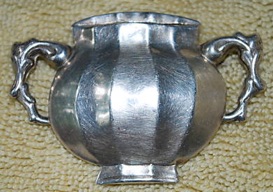
The pin was inspired by a cup at the Governors Palace


(pin photos are from ebay)
Also of interest are two historic spoons
(click on the name to go to that page)
Silver The Geddy Spoon (1770’s)
Pewter The 1675 Copeland Spoon
Examples of 1940’s Marks
prior to the change in 1950 to the oval mark
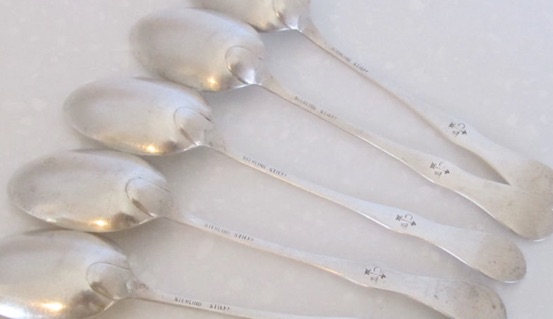
1940’s Coffee Spoons with the early CW mark
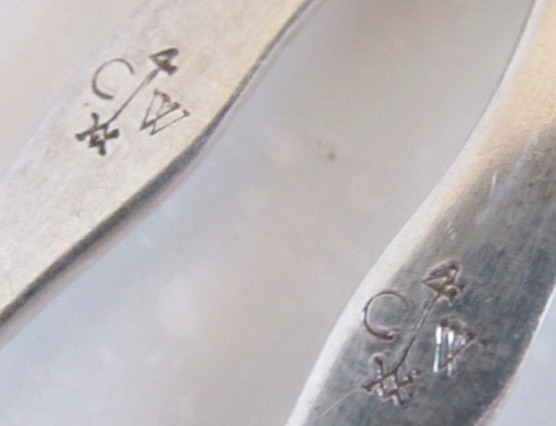
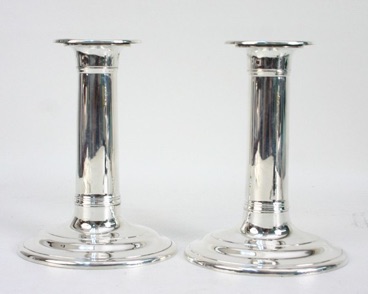

Early Pair of RT 24 Candle Sticks
Below is a SILVER PLATED version of the RT 30 Muffineer
These were made for Colonial Williamsburg for use in the exhibits. It is not
marked as STERLING as it is silver plated. Over the years, these “walked away” from Colonial Williamsburg.
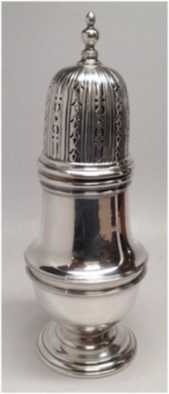

A brief history of
The OFFICE of PRICE STABILIZATION
Office of Price Stabilization also known as the Price Stabilization Board, was the federal agency whose task was to control prices during the Korean War.
The onset of hostilities on 25 June 1950 came as a complete surprise to Americans. Fear of a major conflict with the Soviet Union and still-fresh memories of rationing programs during World War II lead to massive hoarding and panic buying by both consumers and manufacturers. Retail sales for July 1950 increased by 8 percent. After the first month of the war, prices for coffee had increased 9 percent; tin, 26 percent; and rubber, 27 percent. Against this backdrop, on 19 July 1950, in a message to Congress detailing the progress of the war, President Harry Truman asked for limited economic powers to pursue mobilization efforts. This led to the Defense Production Act of 1950, which gave the president the option of imposing rationing and wage and price controls.
Initially, Truman tried to avoid imposing wage and price controls to slow inflation, instead pinning his hopes on credit controls and voluntary compliance. These hopes proved futile. By the end of September 1950, government figures showed that prices for a basket of twenty-eight commodities had increased by 25 percent since the beginning of the war. On 9 September 1951, Executive Order 10161 created the Economic Stabilization Agency (ESA) and Wage Stabilization Board (WSB). The order also allowed for a director of price stabilization under the aegis of the ESA. General Order Number 2 of the ESA formally established the Office of Price Stabilization on 24 January 1951, with Michael DiSalle, mayor of Toledo, as its administrator.
OPS's first act was to announce a price freeze on 26 January 1951. This stopgap measure proved unpopular and unwieldy, and, in many cases, OPS was forced to increase prices. It was not until April 1951 that OPS issued a long-range price control strategy. However, that plan also failed to gather popular support. OPS operations were hampered throughout its existence by the continuous debate over the appropriate level of mobilization and governmental economic control required for an undeclared war. Indeed, Allan Valentine, the first director of ESA, was opposed to establishing price controls. OPS also found many of its efforts undercut by salary rulings of the WSB, especially in the steelworkers' salary dispute of March 1952.
On 6 February 1953, President Dwight Eisenhower's Executive Order 10434 called for the end of all price and wage controls. OPS ended all activities on 30 April 1953 with residual operations passing to ESA
The above excerpt comes from Answers.com
This site, THESTIEFFCOMPANY.COM receives no money or compensation from any of the references or companies listed on this site. We wish to thank others for the use of material from their sites and it is published here as an educational tool only. Some images have come from unknown original sources. If I have used your image without credit or if it needs to be removed, please contact me. We encourage visitors to venture to the other sites shown on this one to learn more about silver and view the images of craftsmanship that they share with all of us. Ad revenues from the google ads helps me maintain this site for the use by silver collectors and those who are just “wondering” about their grandmothers silver and what’s what in the silver chest. I do not make a profit from the publication of this site, it is for educational purposes only.

WE NEED YOUR HELP!
PRODUCING THIS SITE IS COSTLY. IT TAKES A LOT OF TIME AND TO BE HONEST... MONEY, TO HOST THE SITE AND TO BUY THE CATALOGS, PAMPHLETS, PRICE LISTS AND MORE THAT ARE REPRODUCED HERE AS AN EDUCATIONAL TOOL.
I DO NOT CHARGE ANYONE FOR THE SITE. ABOUT A DOZEN EMAILS A WEEK COME IN ASKING FOR HELP IDENTIFYING A PARTICULAR PATTERN OR IN AREAS WHERE ADDITIONAL INFORMATION IS NEEDED.
I HAVE A LOT OF OTHER MATERIALS THAT ARE NOT YET PUBLISHED THAT I CAN GO TO FIND THE ANSWERS ABOUT READERS SILVER OR PEWTER. AGAIN, THIS CAN TAKE A LOT OF TIME... BUT I DO NOT CHARGE FOR THIS SERVICE.
YOU WILL NOT FIND ANY OTHER SITE OUT THERE LIKE THIS ONE... FOR ANY OTHER BRAND OF SILVER. THIS SITE HONORS THE MEN AND WOMEN THAT WORKED AT STIEFF... EITHER AS CLERKS, SILVERSMITHS, DESIGNERS OR WAREHOUSE PEOPLE. THEY ALL ADDED TO THE VALUE AND QUALITY OF THE SILVER AND PEWTER.
YOU CAN HELP ME DEFRAY THE COST OF PRODUCING THIS SITE WITH A SMALL CONTRIBUTION. PLEASE, FEEL FREE TO ADD TO MY PAYPAL ACCOUNT TO SHOW YOUR SUPPORT.
MY PAYPAL ACCOUNT NAME IS SIMPLE,
SCOTTINELMGROVE@YAHOO.COM
THANK YOU






